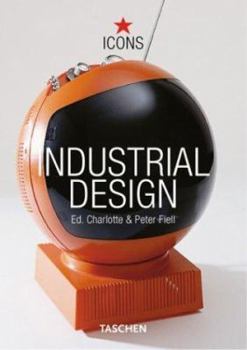Industrial Design
(Part of the Taschen Icons Series)
FROM TOOTHBRUSHES TO CARS: EVERYDAY PRODUCTS DESIGNED BY LUMINARIES. This description may be from another edition of this product.
Format:Paperback
Language:English
ISBN:3822824267
ISBN13:9783822824269
Release Date:December 2003
Publisher:Taschen
Length:192 Pages
Weight:0.87 lbs.
Dimensions:0.5" x 5.6" x 7.8"
Customer Reviews
3 ratings
For anyone interested in design
Published by Thriftbooks.com User , 22 years ago
This book is an excellent source of information and inspiration for anyone interested in design - not only industrial design, though the book covers the topic very well, but design in general, as a form of art. Filled with short biographies of famous designers and quick historical overviews of firms that made impact on design, this books gives an excellent overview of the development of functional design in the 19th and 20th centuries.Aside from this, it has two very interesting sections - "Themes and Materials" and "Case Studies." "Themes and Materials" focuses just on that - the main directions and trends of design in the past two centuries, as well as revolutionary materials that changed the way people worked, played and consumed. "Case Studies" presents several case studies of ordinary (in our view) products, such as the iron, the typewriter, the telephone, etc., and the way the design of these products has changed to reflect their times. The book also includes a design timeline with most important industrial design milestones.The only negative things I can say about this book is that it focuses mainly on US, European (German, Italian and Scandinavian, more specifically) and Japanese firms and inventors, and very little, if anything at all, is said about designers and firms from Canada, South America, Eastern Europe, the countries of the former Soviet Union and Asia.Overall, it is an excellent reference and guide for anyone interested in design and creative thinking. Like all Taschen books, this book is well written, concise yet articulate; beautifully illustrated and printed.
INDISPENSABLE GUIDE TO EVERYDAY THINGS & HOW THEY GOT THERE
Published by Thriftbooks.com User , 23 years ago
If you take even the slightest interest in the design of your toothbrush, the history behind your washing machine, or the evolution of the telephone, you'll take an even greater interest in this new book. This comprehensive volume traces more than three hundred designers and design-led companies, with more than seven hundred illustrations of their most important designs.Individual designers and design firms can be referenced directly via the A-Z of Industrial Design section, which covers more than 550 pages; here you'll find the likes of Enzo Ferrari, Philippe Starck, Zanussi and Apple Computer, among many others. The Case Studies section tracks the history of everyday household appliances from their very beginnings to the present day, illustrating how, for example, your washing machine made the fascinating journey from a wooden tub with gears and cranks to the sleek white cube that it is today. For those interested in the more technical side of industrial design, there's the Themes and Materials section, referencing technological developments and processes such as plywood, steam power and plastics and introducing topics ranging from packaging and branding to CAD (computer assisted design).Exploding with color, aesthetics, and style, Industrial Design is informative and fun. You'll have a hard time putting it down and it will change the way you look at everything around you.
Industrial Design
Published by Thriftbooks.com User , 23 years ago
This book is a great general reference for the world of industrial design. It not only covers top firms and designers, but includes a section on materials and their influence on design. It is not a judgement of good or bad design, but rather a chance to look at all approaches to consumer product development. The images are beautiful, and the book itself is very well-designed. As an industrial design student, the struggle to find interesting text is constant--this one does the trick.






